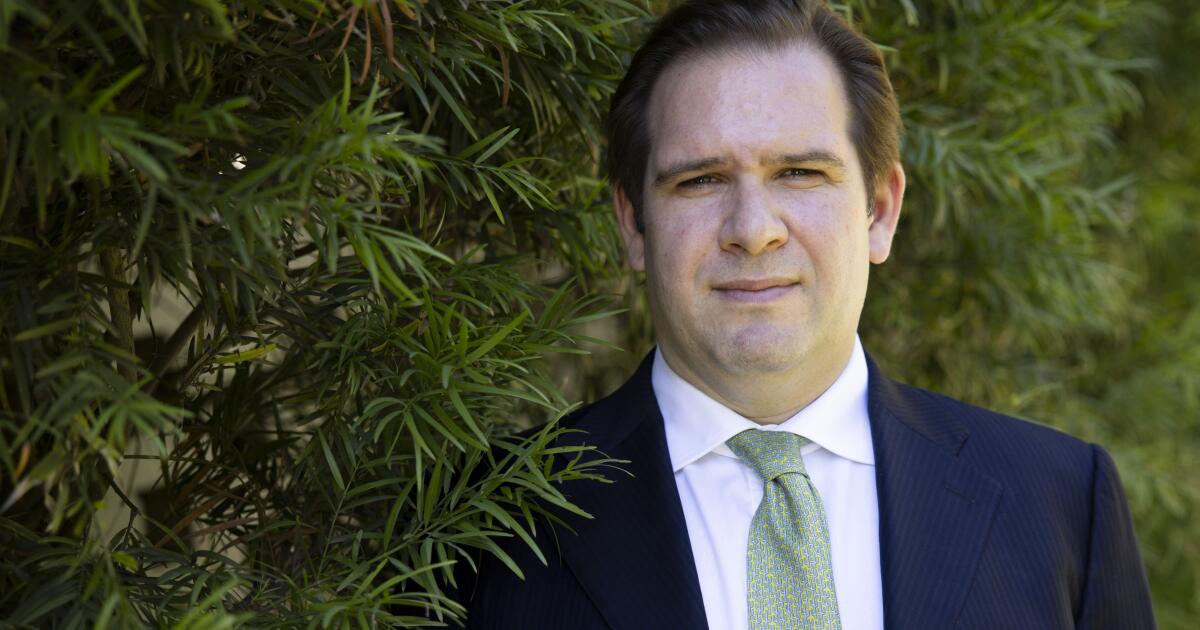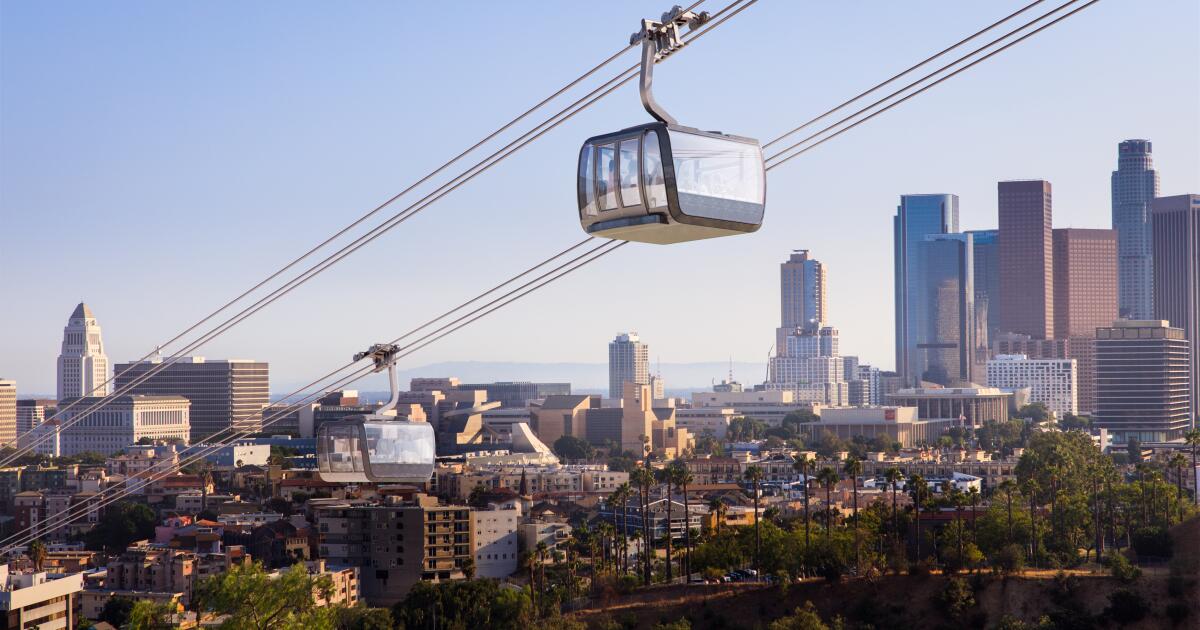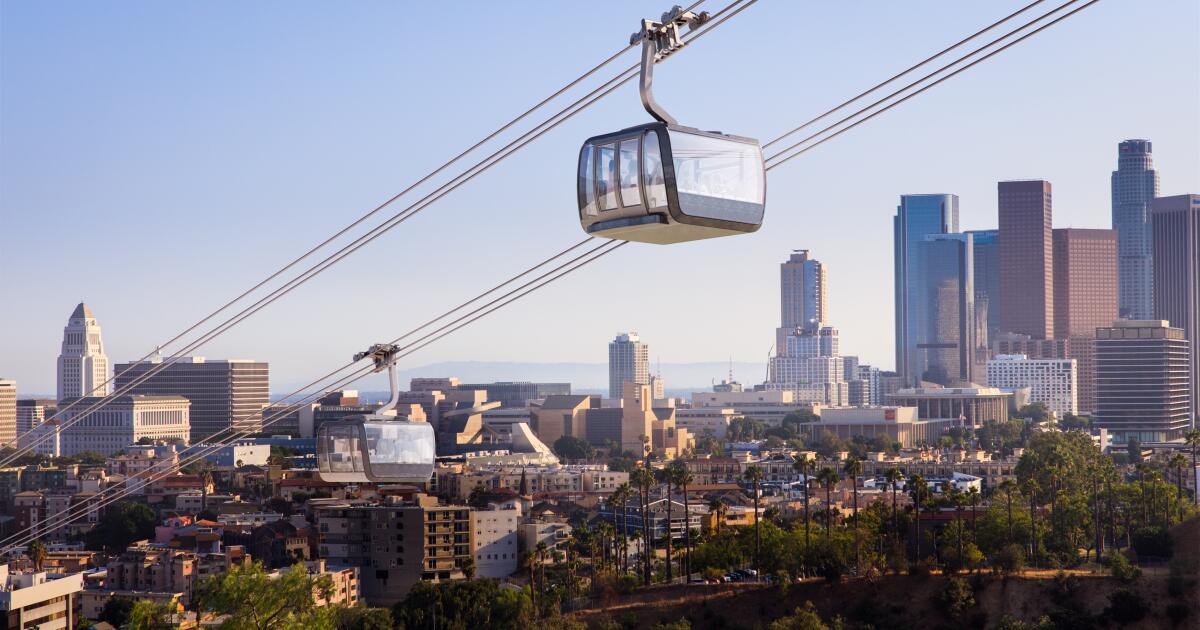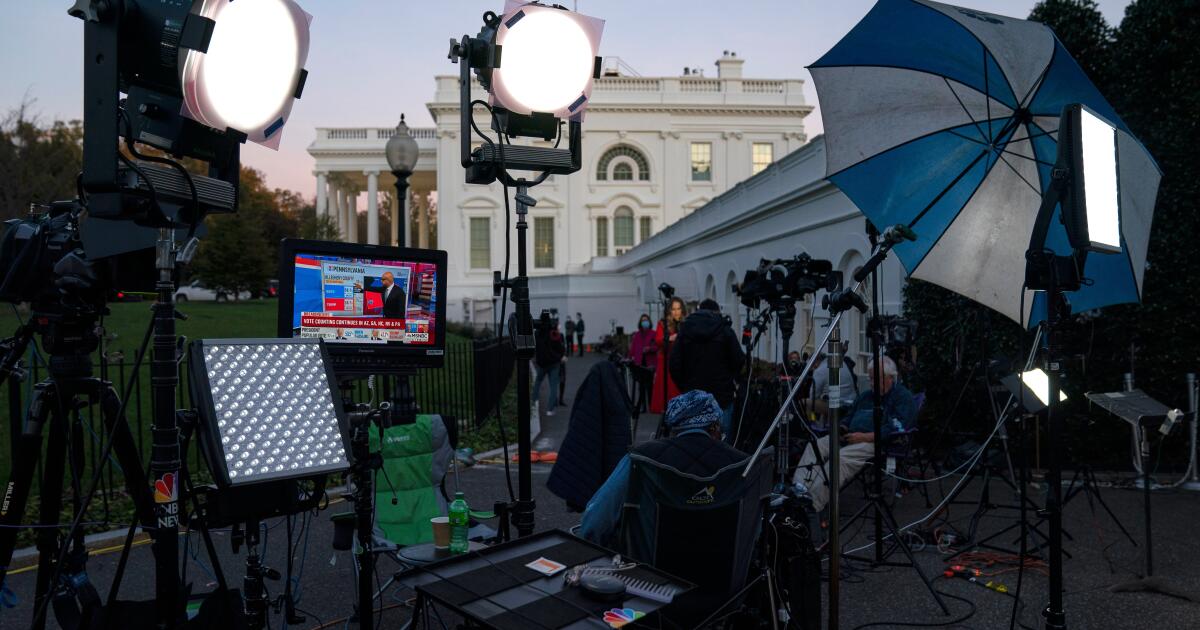He pushed a $1-billion Hollywood studio project. Now, he wants to be L.A.’s next city controller
Good morning, and welcome to L.A. on the Record — our City Hall newsletter. It’s David Zahniser, with an assist from Noah Goldberg, giving you the latest on city and county government.
L.A. City Hall is not known for making things simple for real estate developers — especially those seeking approval of large, complicated projects.
Yet earlier this year, Westwood resident Zach Sokoloff navigated the city’s bureaucratic obstacle course, winning City Council approval of a $1-billion plan to redevelop Television City, the historic studio property on Beverly Boulevard.
Now, Sokoloff is hoping to make what some might view as a baffling career change, jumping from Hackman Capital Partners, where he is senior vice president for asset management, to a job as L.A.’s next elected city controller.
For that to happen, Sokoloff would need to defeat City Controller Kenneth Mejia, who is running for another four-year term in June. That’s a tall order, given Mejia’s social media savvy, his status as an incumbent and his deft use of graphics highlighting the minutiae of city government — sometimes featuring hat-wearing corgis.
In 2022, Mejia secured more votes than any other candidate in city history, as he and his team like to point out. Former state Sen. Isadore Hall, who is also running against Mejia, has his own track record of winning elections.
Sokoloff, by contrast, has never run for public office. He’s spent the past seven years at Hackman, which proposed the 25-acre Television City project and owns other studio properties.
A onetime grade school algebra teacher, Sokoloff promised to emphasize “leadership through listening” if he is elected, shining a light on areas where the city is struggling and working collaboratively to find solutions.
Sokoloff gave some credit to Mejia for seeking to make city government more transparent and understandable. But he argued that such efforts are only a starting point.
Mejia’s audits, he said, “just aren’t moving the needle.”
“He’s shown a preference for lobbing criticism after the fact, rather than getting involved early on to shape the outcome,” Sokoloff said in an interview.
Mejia spokesperson Jane Nguyen pushed back, saying Mejia has championed an array of policy changes, including the creation of a chief financial officer position and a move to “multi-year budgeting.”
In an email, Nguyen said public officials have been responding to Mejia’s audits by working to improve oversight of rents for affordable housing, purchases of military equipment by the Los Angeles Police Department and housing placements by the Los Angeles Homeless Services Authority.
“Despite our small audit staff, this work is ‘moving the needle’ and making a difference in city policies and departments while improving the quality of life of Angelenos,” she said.
Nguyen said her boss has listened to thousands of constituents at community events and at his town hall meetings.
“All politicians ‘listen,’” she said. “The difference between Kenneth Mejia and our opponents is who we listen to. Our Office listens to the people of Los Angeles.”
If Mejia secures a majority of the vote in June, he will avoid a November 2026 runoff. Forcing Mejia into a round two will be a tough task for Hall and Sokoloff, said political science professor Fernando Guerra, who runs the Center for the Study of Los Angeles at Loyola Marymount University.
Because city controller is a relatively low-profile position and Mejia is an incumbent, voters will likely stick with him unless there’s serious “negative publicity,” Guerra said.
“While he’s quirky, there’s nothing there that’s in any way scandalous,” Guerra added.
Sokoloff is launching his campaign at an opportune time. Television City is the subject of several lawsuits, which have been filed not just by neighborhood groups but also The Grove, the shopping mall developed by businessman and former mayoral candidate Rick Caruso. Those plaintiffs have asked a judge to overturn the council’s approval of the project, saying the city failed to comply with CEQA, the state’s environmental law.
Shelley Wagers, who lives nearby and has been fighting the project, said she was surprised by Sokoloff’s decision to run for citywide office. Asked whether he is in fact good at listening, she replied: “Not in my experience, no.”
Sokoloff defended his company’s handling of the TVC project, pointing to the unanimous votes cast by the planning commission and the council.
“We built a broad and diverse coalition of supporters,” he said. “Ultimately, the results of the [city’s] entitlement process speak for themselves.”
Sokoloff has already picked up one key endorsement: Laura Chick, who was perhaps the most confrontational city controller in recent history. Chick, who served in citywide office from 2001 to 2009, took on officials at the city’s harbor, its airport agency, the city attorney’s office and many others.
Chick, who now lives in the San Francisco Bay Area, said L.A. needs a controller who will find strategies to make the city more efficient and effective.
“[Sokoloff] understands that L.A. needs an active problem solver as its chief auditor,” she said.
State of play
— CREATING A RECORD: Mayor Karen Bass, Councilmember Eunisses Hernandez and an assortment of elected officials, clergy and community activists went to a four-hour hearing this week that focused on the impact — and alleged abuses — of Trump’s immigration crackdown. “We want to establish a record, because when the political winds change, we want to hold those accountable,” Bass said.
— THANKSGIVING TEXTS: Caruso, the real estate developer now weighing a second run for mayor, offered his own message on the immigration raids this week, sending a text message blast asking for donations to help families whose lives have been upended by crackdown.
“As we get ready to sit down with family tomorrow, I’m thinking about the families across our city whose Thanksgiving will look a little different,” Caruso wrote on Wednesday. “Many are afraid to return to work after the recent workplace raids, leaving families short on food, rent, and basic necessities.”
— CONCEPT OF A PLAN: Mayoral candidate Austin Beutner said he supports “the concept” of hiking L.A.’s sales tax by a half-cent to pay for additional firefighters and fire stations. Beutner offered his take a few days after the firefighters union confirmed it is preparing ballot language for the tax, which would raise $9.8 billion by 2050. The union wants voters to take up the measure in November 2026.
— FIRE FUNDING: Even without the tax, Fire Chief Jaime Moore is asking for more than $1 billion for his department’s next annual budget, a 15% hike over the current year. Moore said the additional funds are needed to ensure the city is prepared for emergencies like the Palisades fire.
— DIALING 9-1-1: Sticking with the firefighting theme, Beutner posted an interactive graphic on his website showing how much paramedic response times have increased in most zip codes in the city. Beutner said firefighters are being asked to respond to too many non-emergency calls.
— DELAYED RESPONSE: Residents in neighborhoods near the Port of Los Angeles were not told to shelter in place until nearly six hours after a massive hazardous materials fire broke out aboard a cargo ship in the harbor. The handling of the alert, which urged residents to go inside immediately and shut their doors and windows, follows deep concerns about the region’s alert system and how it worked during the Eaton fire in January.
— KATZ OUT THE BAG: The five-member board that oversees the Department of Water and Power has lost its third commissioner in as many months. Richard Katz, a former state lawmaker and a Bass appointee, had his final meeting on Nov. 18. In his resignation letter, he said he’s stepping aside to focus on two upcoming surgeries.
— LACKING A QUORUM: Because the DWP board needs three members to hold a meeting, it won’t be able to conduct any business until the council confirms the mayor’s newest appointee: Benny Tran, who is slated to replace Mia Lehrer. Tran is a principal with Baobab Global Consulting, according to his nomination paperwork.
— IN HOT WATER: A high-ranking DWP employee has been accused of making staffers run personal errands for her on city time, including purchasing tickets to a Snoop Dogg concert, according to a filing lodged by the Los Angeles City Ethics Commission’s director of enforcement. The employee’s lawyer said the claims were the product of a disgruntled subordinate.
— MONEY TROUBLES: L.A. County’s Department of Homeless Services and Housing faces a $230-million financial gap in the upcoming budget year, setting the stage for cuts to key services. Officials are looking at scaling back an array of programs, including services to help homeless residents find apartments.
— BOLSTERING THE BUDGET: The council’s new Budget and Finance Advisory Committee, a five-member citizen panel looking at ways to strengthen the city’s finances, held its first meeting this week, selecting former City Controller Ron Galperin as its chairman. The committee plans to look at the city’s investment strategies, real estate portfolio, legal obligations and overall approach to annual budgets.
QUICK HITS
- Where is Inside Safe? The mayor’s signature program to combat homelessness did not launch new operations this week.
- On the docket next week: The Charter Reform Commission is set to hold an outdoor town hall Saturday at Echo Park Lake. The event, which runs from 10 a.m. to 1:30 p.m., will take place on the northeast lawn at Echo Park and Park avenues.
Stay in touch
That’s it for this week! Send your questions, comments and gossip to [email protected]. Did a friend forward you this email? Sign up here to get it in your inbox every Saturday morning.

















